Photographs: Finbarr O'Reilly/Reuters
Everything about diamonds is truly fascinating. It almost enthrals you every time you walk into a jewellery store.
When the salesperson starts explaining the 4Cs -- cut, clarity, carat and colour -- this alluring piece of stone becomes even more enchanting.
So, why is there so much fuss around diamonds? ...
All that's there to the sparkling diamond
Photographs: Arko Datta/Reuters
A diamond is basically carbon in its most concentrated form. Most natural diamonds are formed at high temperature and pressure at depths of 140 to 190 kilometers (87 to 120 mi) in the Earth mantle.
Carbon-containing minerals provide the carbon source, and the growth occurs over periods from 1 billion to 3.3 billion years (25 to 75 per cent of the age of the Earth).
Diamond has remarkable optical characteristics. Because of its extremely rigid lattice, it can be contaminated by very few types of impurities, such as boron and nitrogen. Combined with wide transparency, this results in the clear, colourless appearance of most natural diamonds.
...
All that's there to the sparkling diamond
Photographs: Michael Buholzer/Reuters
People first began to suspect that diamonds might have occurred just outside of the quiet town of Murfreesboro, Arkansas in US.
But, the first diamonds were found in Pike County, Arkansas and were discovered in August 1906 by John Wesley Huddleston.
...
All that's there to the sparkling diamond
Photographs: Denis Balibouse/Reuters
Even though diamonds have been adorning various kinds of jewellery, history says that scientists had not unearthed the secret of the formation of a diamond until the late twentieth century.
In the last 50 years, physicists, gemologists, mineralogists and chemists have been able to put their knowledge together to come up with all that we do know today.
...
All that's there to the sparkling diamond
Image: Artisanal diamond miners work at Tumbodu, north of the town of Koidu in eastern Sierra LeonePhotographs: Simon Akam/Reuters
How diamonds are mined?
Diamonds are a naturally occurring stone, and diamond mining is much more of a high tech science than a speculators bonanza. It is interesting to note that of all the diamonds mined each year, a surprisingly small amount, about 50 per cent are high enough quality to turn into jewellery. The rest don't even reach us.
...
All that's there to the sparkling diamond
Image: A miner washes muddy gravel in the hope of finding diamondsPhotographs: Katrina Manson/Reuters
Types of diamond mining
Typically, diamonds are found in a type of igneous rock known as kimberlite. Diamonds are the hardest (naturally formed) substance in the world.
There are two common types of commercial diamond mining, Kimberlite Pipe Mining and Alluvial Mining.
...
All that's there to the sparkling diamond
Image: Employees work at a diamond factory in SuratPhotographs: Arko Datta/Reuters
The other stages that a rough diamond usually passes through are crushing, separating, greasing and cutting.
Crushing
In the crushing operation, which occurs in the below-ground mining facilities, large chunks of kimberlite are broken up into more easily transportable segments. If the crushed chunks do not pass through the grizzly, they are still too large, and they are sent back for further crushing.
...
All that's there to the sparkling diamond
Photographs: Tyrone Siu/Reuters
Separating
The actual diamonds must be separated from the rock that surrounds them. A gravity-based device is used to sort the diamond-containing portions -- called the concentrate --from the tailing or the filler rock. One of the most commonly used methods to separate the two is a type of washing pan developed in South Africa in the 1870s.
...
All that's there to the sparkling diamond
Photographs: Tyrone Siu/Reuters
Another method of uncovering diamonds uses media separators. A stew called slurry is made up -- typically consisting of water added to the crushed concentrate and tailings. Ferro-silicon powder, which has a heavy density, is also added.
...
All that's there to the sparkling diamond
Photographs: Tyrone Siu/Reuters
Greasing
After this rudimentary separation, the concentrate moves to a greasing area, another innovation in diamond manufacturing developed in South Africa in the late 19th century.
The method operates on the premise that diamonds newly excavated will not become wet when brought into contact with water. Instead they will stick to the grease. Petroleum jelly is usually the preferred substance on the grease belt or table.
In a newer method, X-ray technology is used to determine which of the concentrate is diamond and which is effluvial material.
...
All that's there to the sparkling diamond
Image: A view of a diamond cutting factory in Botswana's capital GaboronePhotographs: Joan Sullivan/Reuters
Cutting
Diamond cutting is the practice of changing a diamond from a rough stone into a faceted gem. Cutting diamond requires specialised knowledge, tools, equipment, and techniques because of its extreme difficulty.
The diamond cutting process includes these steps; planning, cleaving or sawing, bruting, polishing, and final inspection.
...
All that's there to the sparkling diamond
Image: Diamonds are displayed at the certification level of the World Diamond Centre in AntwerpPhotographs: Yves Herman/Reuters
Even after the diamonds are sorted and shipped to their prospective markets, either to jewellery makers or industrial users of diamonds, they are sorted even more. The quality of a rough diamond finally determines what it will ultimately be used for.
...
All that's there to the sparkling diamond
Photographs: Yves Herman/Reuters
Diamonds are valued as both a consumer and industrial product. The mining and sale of diamonds is an international, multi-billion dollar industry. It is also an industry that has been plagued in recent years by the issue of so-called conflict diamonds or blood diamonds.
...
All that's there to the sparkling diamond
Image: The Mouawad 1001 Nights Diamond PursePhotographs: Fadi Al-assaad/Reuters
The most commercially viable diamonds mines are found in Canada, Russia, Australia, Botswana, The Democratic Republic of Congo and Siberia.
...
All that's there to the sparkling diamond
Photographs: Tyrone Siu/Reuters
In some of the unstable countries of Africa, revolutionary groups have taken over control of some of the diamond mines. Blood Diamonds is the term used for diamonds mined and sold in this way.
...
All that's there to the sparkling diamond
Image: An illegal diamond dealer from Zimbabwe displays diamonds for sale in Manica, near the border with ZimbabwePhotographs: Goran Tomasevic/Reuters
A conflict diamond or blood diamond is the one that has been stolen or illegally mined and then sold to raise money for rebel militia or terrorist groups.
These groups earn money for weapons by forcing men, women and children to dig for diamonds. Most conflict diamonds come from Angola, the Democratic Republic of the Congo, the Ivory Coast, Liberia and Sierra Leone.
But, all diamonds are not conflict diamonds.
...
All that's there to the sparkling diamond
Photographs: Toby Melville ASA/Reuters
To ensure that diamonds are sold and extracted in a legal manner, the United Nations introduced the Kimberly Process in 2002.
The Kimberly Process ensures that diamonds exported from these countries are documented and certified and are not mined and acquired in this way.
The diamond industry and countries buy diamonds through this process in order to fight against these blood diamonds.
...
All that's there to the sparkling diamond
Image: A necklace featuring the Evening Star, a 39 carat, D colour Golconda diamond, estimated to sell for between $3.6 and $5.5 millionPhotographs: Finbarr O'Reilly/Reuters
A diamond is typically judged based on the well-known 4Cs:
Cut - This refers to a diamond's geometric proportions and how it has been cut. When a diamond is cut, facets are created and the diamond's finished shape is determined.
Clarity - This is the measurement of a diamond's flaws, or inclusions that are seen in the diamond. Clarity levels begin with Flawless and move down to Very Very Slight (VVS), Very Slight (VS) and Slightly Included (SI).
Carat - This is the weight of a diamond. One carat is equal to about 200 milligrams.
Colour - In referring to transparent diamonds, the colour scale runs from D to Z, beginning with Icy White -- the colour of the most expensive transparent diamonds -- and ending with a light yellow.
...
All that's there to the sparkling diamond
Image: he "Martian Pink", a 12.04-carat Fancy Intense pink (Type IIa) diamondPhotographs: Tyrone Siu/Reuters
Diamond type is a method of scientifically classifying diamonds by the level and type of their chemical impurities. Diamonds are separated into four types: Type Ia, Type Ib, Type IIa, and Type IIb.
The impurities measured are at the atomic level within the crystal lattice of carbon atoms and so, unlike inclusions, require an infrared spectrometer to detect.
...
All that's there to the sparkling diamond
Photographs: Michael Buholzer/Reuters
Diamonds are found in nature in a variety of hues. Colourless or white diamonds are the most common, while some tinted stones are rare and valuable.
The shades may be yellow, blue, pink, green, or amber. In South Africa it is common to see orange diamonds as jewellery, but this is a custom that has not made its way into the rest of the world.
...
All that's there to the sparkling diamond
Photographs: Stephen Hird/Reuters
If you don't want to go for the real diamonds, you can always opt for synthetic diamonds. They are manufactured in a laboratory, as opposed to diamonds mined from the Earth.
The gemological and industrial uses of diamond have created a large demand for rough stones. This demand has been satisfied in large part by synthetic diamonds, which have been manufactured by various processes for more than half a century.
...
All that's there to the sparkling diamond
Photographs: Arnd Wiegmann/Reuters
Though diamonds have meant different things to different societies, it is still considered valuable. Until the 15th century, they were seen by leaders as symbols of supreme strength. The name itself comes from the Greek word "adamas", meaning indestructible.
...
All that's there to the sparkling diamond
Photographs: Luke MacGregor/Reuters
Many believe diamonds have a magical quality -- fuelled by the fact that many glow in the dark. As a result, they have been used as a cure for madness, to ward off evil spirits and devils, and even as a cure for nightmares.
The Greek philosopher Plato was said to share the belief that diamonds were living spirits. Diamond "powder" has also been used as a potent poison -- apparently one favoured by Catherine de Medici in the 16th century.
...
All that's there to the sparkling diamond
Photographs: Toby Melville/Reuters
Diamonds are not only good for investment; it is also considered a symbol of love. We have a particularly romantically-minded Austrian aristocrat to thank for that innovation. Archduke Maximilian decided to give his fiancee, Mary of Burgundy, a diamond ring when he proposed to her in 1477.
This trend caught on, though the custom of wearing the ring on the third finger of the left hand has been around since the ancient Egyptians.
...
All that's there to the sparkling diamond
Photographs: Peter Macdiarmid/Reuters
Since then diamonds gained even more importance. If you like to be part of this tradition, stalk your diamonds early as there are reports that the coloured varieties are in short supply – some of the main providers say they might run out within a decade.
But as demand for the gems increases with the growing ranks of the middle classes in China and India, demand could be met by diamonds manufactured in the laboratory.
...
All that's there to the sparkling diamond
Photographs: Francois Lenoir/Reuters
However, diamonds weren't always used for jewellery. Harvard physicist Peter Lu and colleagues found that ancient Chinese used diamonds to polish ceremonial burial axes in the late stone age or over 4,500 years ago.
...
All that's there to the sparkling diamond
Photographs: Yves Herman/Reuters
This usage was changed by companies like De Beers. In fact, it is said that De Beers that single-handedly made the diamond industry what it is today. De Beers was founded by Cecil Rhodes, who also founded the state of Rhodesia which later became Zambia and Zimbabwe.
Rhodes started by renting water pumps to miners during a diamond rush in 1867 at Kimberley, South Africa. He expanded into mines and about twenty years later became the sole owner of all diamond mining operations in the country.
...
All that's there to the sparkling diamond
Image: Displayed here are rough diamonds during their sorting processPhotographs: Juda Ngwenya/Reuters
In the early days, De Beers controlled about 90 per cent of the world's diamond supply. Today, its monopoly on diamonds has been significantly reduced. It is estimated that the cartel now controls about 60 to 75 per cent of the world's diamond trade.
...
All that's there to the sparkling diamond
Image: Curator Caroline de Guitaut poses with the Cullinan VII necklace at the Queen's Gallery in Buckingham Palace in LondonPhotographs: Stefan Wermuth/Reuters
Here's a list of some famous diamonds:
The Cullinan - This 3,106-carat diamond is the largest diamond ever found. It was discovered in 1905 in Transvaal, South Africa.
The Hope Diamond - Possibly the most famous diamond in America, this 45.52-carat diamond is on display at the National Museum of Natural History in Washington D.C. Its history dates back to the 1600s, when it was originally a 112.1875-carat diamond.
...
All that's there to the sparkling diamond
Photographs: Toby Melville/Reuters
The Excelsior - Perhaps the second-largest diamond ever found, the Excelsior was found in 1893 in South Africa. The original stone weighed about 995 carats.
The Great Mogul - Believed to be the third-largest uncut diamond ever found, it was discovered around 1650. Its original size is said to have been 787.50 carats, but it was cut to just 280 carats.

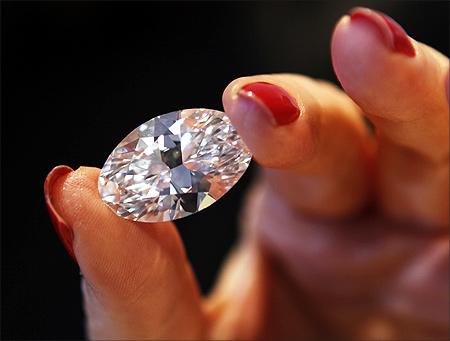
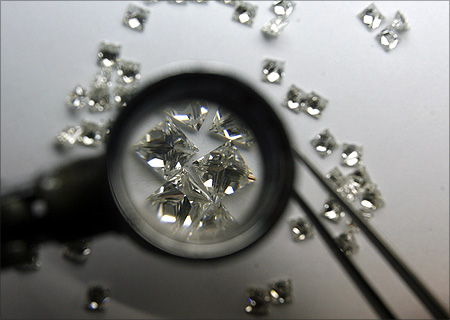
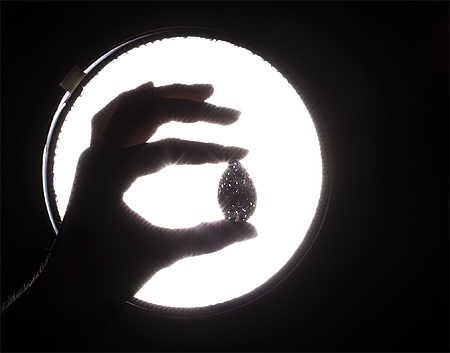
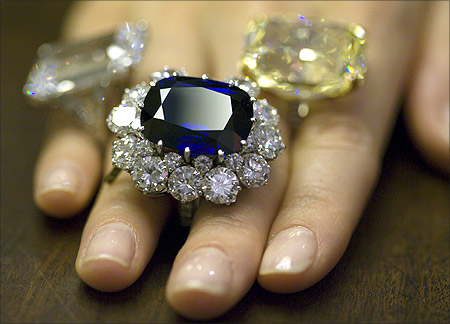
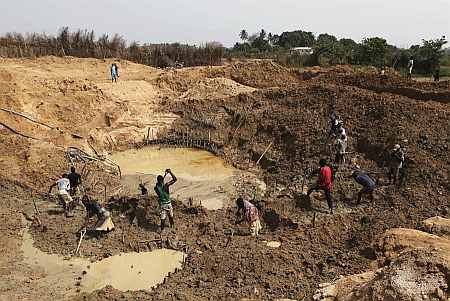
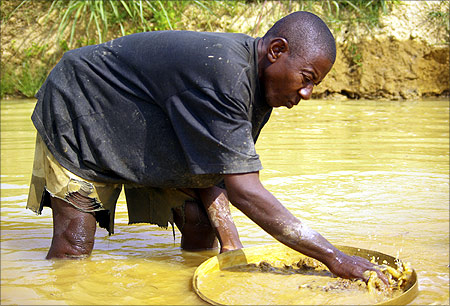
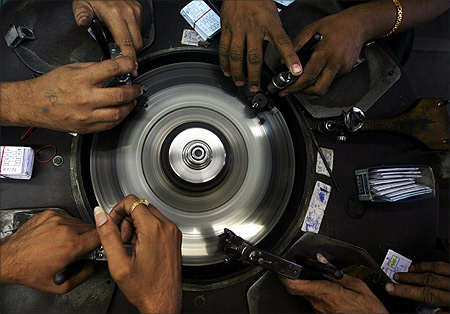
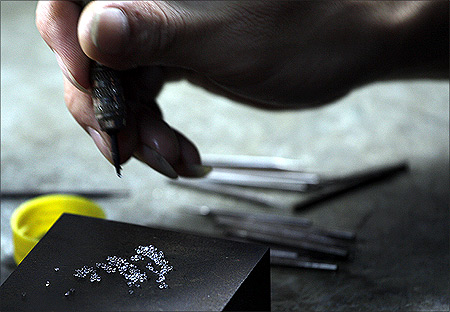
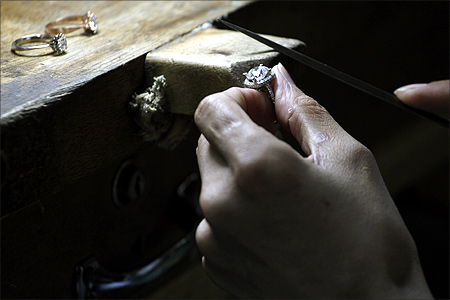


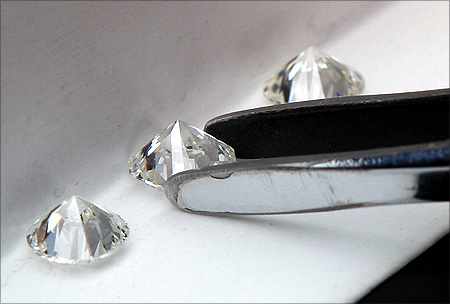
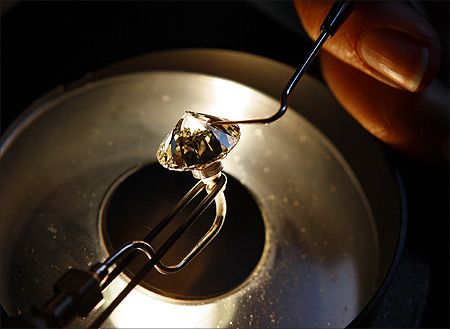
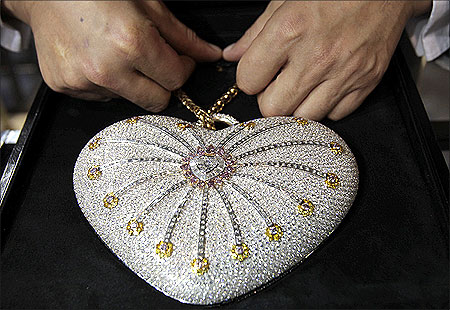


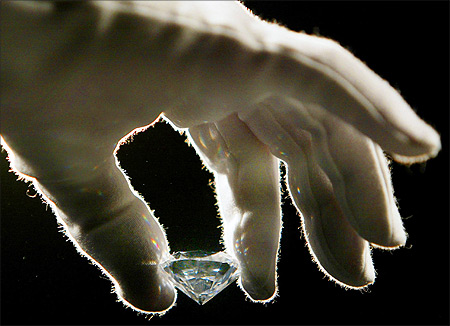

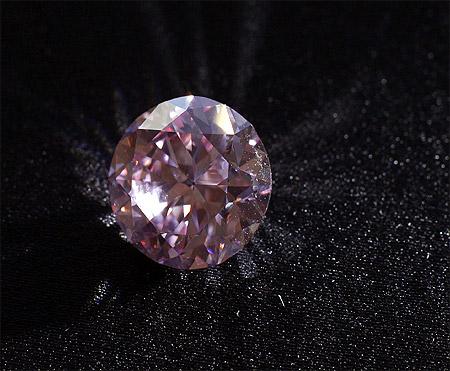
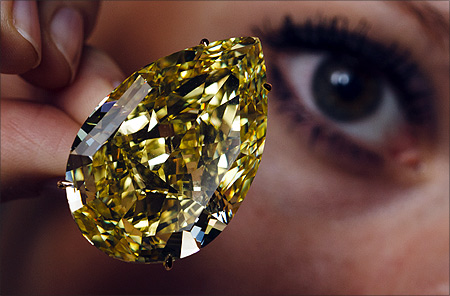
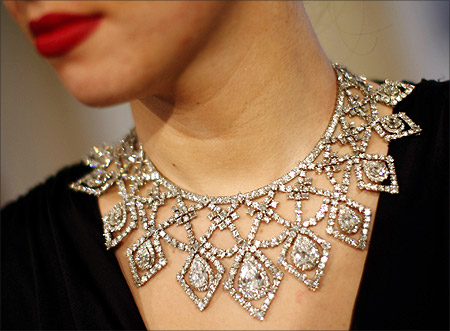

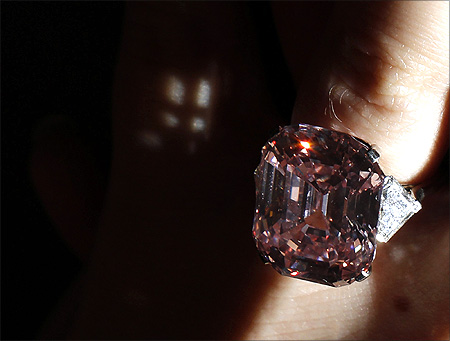
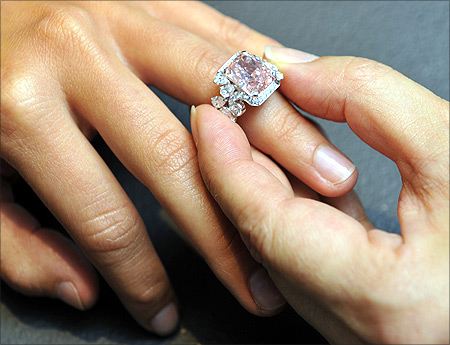
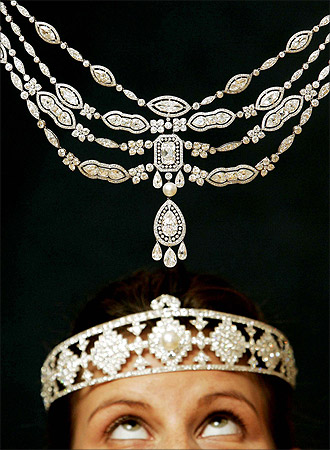

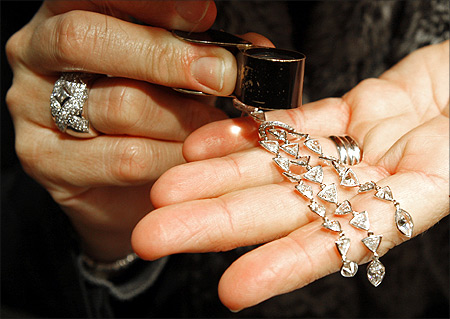
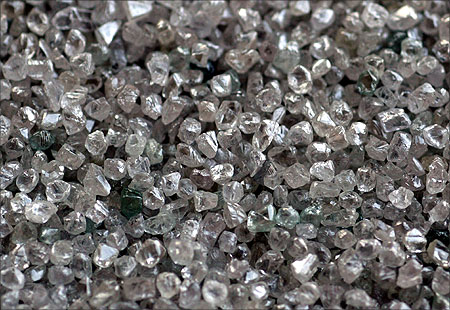

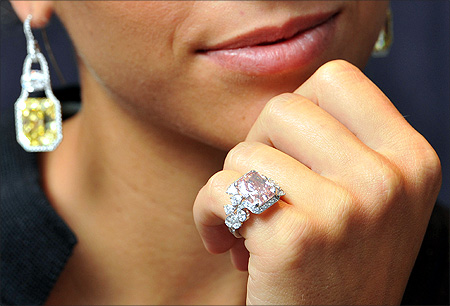
article